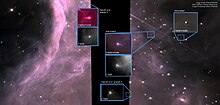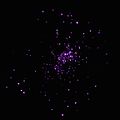| Emission nebula | |
|---|---|
 The Flame Nebula (NGC 2024) - based on Chandra X-Ray and Spitzer Infrared images. The Flame Nebula (NGC 2024) - based on Chandra X-Ray and Spitzer Infrared images. | |
| Observation data: J2000.0 epoch | |
| Right ascension | 05 41 54 |
| Declination | −01° 51′ 0.0″ |
| Distance | 1350 ly (415 pc) |
| Apparent magnitude (V) | 10 |
| Apparent dimensions (V) | 30'x30' |
| Constellation | Orion |
| Physical characteristics | |
| Radius | 6 ly |
| Designations | NGC 2024 and Sharpless 277 |
| See also: Lists of nebulae | |
The Flame Nebula, designated as NGC 2024 and Sh2-277, is an emission nebula in the constellation Orion. It is about 1350 light-years away. At that distance, the Flame Nebula lies within the Orion B cloud of the larger Orion Molecular Cloud Complex.
The bright star Alnitak (ζ Ori), the easternmost star in the Belt of Orion, appears very close to the Flame Nebula in the sky. But the star and nebula are not physically associated with one another. The Flame Nebula contains a young cluster of stars which includes at least one hot, luminous O-type star labeled IRS 2b. The dense gas and dust in the foreground of the nebula heavily obscures the star cluster inside the nebula, making studies at infrared wavelengths most useful.
The energetic ultraviolet light emitted by the central O-type star IRS 2b into the Flame Nebula causes the gas to be excited and heated. The glow of the nebula results from the energy input from this central star. Within the nebula and surrounding the central hot star is a cluster of young, lower-mass stars, 86% of which have circumstellar disks. X-ray observations by the Chandra X-ray Observatory show several hundred young stars, out of an estimated population of 800 stars. X-ray and infrared images indicate that the young stars are concentrated near the center of the cluster.

The Flame Nebula was observed with ALMA and this study found two populations, which are separated by a molecular cloud. The eastern population is 0.2-0.5 Myr old and has a disk fraction of 45±7%. The western population is slightly older at 1 Myr and has a lower disk fraction of 15±4%. This disk fraction is lower than the one observed in the mid-infrared, but the ALMA survey also observed a smaller region. The eastern part contains the O8 star IRS 2b and the western part contains the B0.5V star IRS 1. Hubble observations have shown that the Flame Nebula contains 4 clear proplyds and 4 candidate proplyds. Three of these are in the older western region and are pointing towards IRS 1. The other 5 are in the younger eastern region and are pointing towards IRS 2b.
Gallery
-
 Optical image in B, V and R filters, from La Silla Observatory
Optical image in B, V and R filters, from La Silla Observatory
-
 Infrared image, from 2MASS
Infrared image, from 2MASS
-
 Near-infrared image, from VISTA
Near-infrared image, from VISTA
-
 Visible light wide-field view of region of Orion's Belt and the Flame Nebula
Visible light wide-field view of region of Orion's Belt and the Flame Nebula
-
 NGC 2024 seen by the Chandra X-ray Observatory
NGC 2024 seen by the Chandra X-ray Observatory
-
 Flame Nebula and Horsehead Nebula
Flame Nebula and Horsehead Nebula
-
 Horsehead and Flame Nebulae in H-alpha
Horsehead and Flame Nebulae in H-alpha
References
- ^ Meyer, M. R.; et al. (2008). "Star Formation in NGC 2023, NGC 2024, and Southern L1630". In Reipurth, B. (ed.). Handbook of Star Forming Regions, Volume II: The Southern Sky ASP Monograph Publications. Vol. 5. Astronomical Society of the Pacific. p. 43. Bibcode:2008hsf1.book..662M. ISBN 978-1-58381-670-7.
- Bik, A.; et al. (2003). "Identification of the ionizing source of NGC 2024". Astronomy & Astrophysics. 404 (1): 249–254. arXiv:astro-ph/0303029. Bibcode:2003A&A...404..249B. doi:10.1051/0004-6361:20030301.
- Haisch, K. E. Jr.; Lada, E. A.; Lada, C. J. (2000). "A Near-Infrared L-Band Survey of the Young Embedded Cluster NGC 2024". Astronomical Journal. 120 (2): 1396–1409. arXiv:astro-ph/0006219. Bibcode:2000AJ....120.1396H. doi:10.1086/301521. S2CID 18143699.
- ^ Haisch, K. E. Jr.; et al. (2001). "A Mid-Infrared Study of the Young Stellar Population in the NGC 2024 Cluster". Astronomical Journal. 121 (3): 1512–1521. arXiv:astro-ph/0012482. Bibcode:2001AJ....121.1512H. doi:10.1086/319397. S2CID 1645511.
- Skinner, S.; Gagné, M.; Belzer, E. (2003). "A Deep Chandra X-Ray Observation of the Embedded Young Cluster in NGC 2024". Astrophysical Journal. 598 (1): 375–391. arXiv:astro-ph/0306566. Bibcode:2003ApJ...598..375S. doi:10.1086/378085. S2CID 18798394.
- Broos, P. S.; et al. (2013). "Identifying Young Stars in Massive Star-forming Regions for the MYStIX Project". Astrophysical Journal. 209 (2): 32. arXiv:1309.4500. Bibcode:2013ApJS..209...32B. doi:10.1088/0067-0049/209/2/32. S2CID 67827240.
- Kuhn, M. A.; Getman, K. V.; Feigelson, E. D. (2015). "The Spatial Structure of Young Stellar Clusters. II. Total Young Stellar Populations". Astrophysical Journal. 802 (1): 60. arXiv:1501.05300. Bibcode:2015ApJ...802...60K. doi:10.1088/0004-637X/802/1/60. S2CID 119309858.
- Getman, K. V.; Feigelson, E. D.; Kuhn, M. A. (2014). "Core-Halo Age Gradients and Star Formation in the Orion Nebula and NGC 2024 Young Stellar Clusters". Astrophysical Journal. 787 (2): 109. arXiv:1403.2742. Bibcode:2014ApJ...787..109G. doi:10.1088/0004-637X/787/2/109. S2CID 118503957.
- Nemiroff, R.; Bonnell, J., eds. (10 May 2014). "Inside the Flame Nebula". Astronomy Picture of the Day. NASA. Retrieved February 14, 2015.
- ^ van Terwisga, S. E.; van Dishoeck, E. F.; Mann, R. K.; Di Francesco, J.; van der Marel, N.; Meyer, M.; Andrews, S. M.; Carpenter, J.; Eisner, J. A.; Manara, C. F.; Williams, J. P. (2020-08-01). "Protoplanetary disk masses in NGC 2024: Evidence for two populations". Astronomy and Astrophysics. 640: A27. arXiv:2004.13551. Bibcode:2020A&A...640A..27V. doi:10.1051/0004-6361/201937403. ISSN 0004-6361.
- Haworth, Thomas; Jinyoung, Kim; Winter, Andrew; Hines, Dean; Clarke, Cathie; Sellek, Andrew; Ballabio, Giulia; Stapelfeldt, Karl (March 2021). "Proplyds in the flame nebula NGC 2024". Monthly Notices of the Royal Astronomical Society. 501 (3): 3502–3514. arXiv:2012.09166. doi:10.1093/mnras/staa3918.
External links
- "NGC 2024". SIMBAD. Centre de données astronomiques de Strasbourg.
- Nemiroff, R.; Bonnell, J., eds. (13 July 1999). "The Flame Nebula in Infrared". Astronomy Picture of the Day. NASA.
- The Flame Nebula on WikiSky: DSS2, SDSS, GALEX, IRAS, Hydrogen α, X-Ray, Astrophoto, Sky Map, Articles and images
| Astronomical catalogs | |
|---|---|
| NGC | |